Exploring the enigmatic remnants of bygone civilizations leads scholars to the captivating complexities of the pioneering Sumerians. Among these remnants, the Sumerian cylinder seals stand out as peculiar cylindrical artifacts adorned with intricate designs that continue to perplex and intrigue researchers. These relics provoke debates and fascination, with some interpretations suggesting the presence of figures clad in what appear to be spacesuits, igniting discussions on encounters with extraterrestrial beings or the symbolism hidden within these ancient engravings.
Central to these discussions are the multifunctional roles that Sumerian cylinder seals played in ancient Mesopotamia. These objects served as signatures, talismans, or administrative tools. Crafted from stone or clay, these seals featured elaborate designs meticulously etched and impressively rolled onto various surfaces like clay tablets. Amidst the diverse motifs found on Sumerian cylinder seals, some depict humanoid forms dressed in intricate garments reminiscent of advanced spacesuits.
Proponents of the extraterrestrial theory linked to Sumerian cylinder seals argue that these depictions provide evidence of encounters with otherworldly beings. They highlight the intricate features of the suits – helmets, gloves, and equipment resembling breathing apparatuses – as indications of technology far beyond the capabilities of ancient civilizations. Furthermore, the consistent portrayal of these suits across different seals suggests intentional repetition rather than random artistic creation.

Supporters of the ancient astronaut hypothesis draw parallels between Sumerian depictions and contemporary UFO sightings, as well as narratives of extraterrestrial encounters. They propose that the similarities between ancient and modern accounts indicate a shared experience transcending time and cultural boundaries. According to this perspective, the Sumerians might have witnessed or interacted with beings from distant worlds, immortalizing these encounters through their artistic expressions.
Conversely, skeptics present alternative viewpoints on the figures in spacesuits depicted on Sumerian cylinder seals. They suggest that these suits could symbolize deities or mythological entities rather than direct representations of alien beings. In Mesopotamian mythology, gods and goddesses often appeared in anthropomorphic forms, blurring the boundaries between human and divine. Therefore, the figures on the seals might symbolize these mythical beings rather than actual extraterrestrial entities.
Rejecting the imposition of contemporary interpretations on ancient relics, critics emphasize the importance of cultural context in understanding Sumerian art. Without tangible evidence, such as remnants of advanced technology or explicit references to alien contact, the ancient astronaut theory remains speculative.
Introducing an alternative perspective, some interpret the depictions of beings in spacesuits on Sumerian cylinder seals as allegorical or symbolic representations. In ancient beliefs, the heavens symbolized the domain of divine entities who controlled human destinies. Thus, the depiction of figures in spacesuits may symbolize these celestial beings rather than concrete representations of extraterrestrial visitors.
In conclusion, the ongoing discourse surrounding Sumerian cylinder seals featuring figures in spacesuits incites curiosity and contemplation among scholars and enthusiasts. Whether these depictions allude to alien encounters, symbolize mythological entities, or simply reflect artistic creativity, the mysterious allure of Sumerian art endures, prompting exploration of ancient mysteries and the potential for encounters with beings beyond our terrestrial realm.
